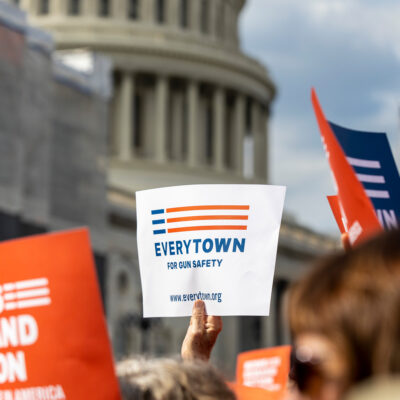Extreme Risk Laws
What does it solve?
When a person is in crisis and considering harming themselves or others, family members and law enforcement are often the first people to see the warning signs. Extreme Risk laws, sometimes referred to as “Red Flag” laws, allow loved ones or law enforcement to intervene by petitioning a court for an order to temporarily prevent someone in crisis from accessing guns.
These laws can help de-escalate emergency situations. Extreme Risk laws are a proven way to intervene before gun violence—such as a gun suicide or mass shooting—takes more lives.
Extreme Risk Law
Which states have Extreme Risk laws?
Extreme Risk Law
Alabama has not adopted this policy
Extreme Risk Law
Alaska has not adopted this policy
Extreme Risk Law
Arizona has not adopted this policy
Extreme Risk Law
Arkansas has not adopted this policy
Extreme Risk Law
California has adopted this policy
- Who may petition for an order?
- Law enforcement, immediate family members, employers, coworkers, teachers, roommates, people with a child in common or who have a dating relationship
Extreme Risk Law
Colorado has adopted this policy
- Who may petition for an order?
- Law enforcement, family/household members, certain medical professionals, and certain educators
Extreme Risk Law
Connecticut has adopted this policy
- Who may petition for an order?
- Law enforcement, family/household members, and medical professionals
Extreme Risk Law
Delaware has adopted this policy
- Who may petition for an order?
- Law enforcement and family members
Extreme Risk Law
Florida has adopted this policy
- Who may petition for an order?
- Law enforcement only
Extreme Risk Law
Georgia has not adopted this policy
Extreme Risk Law
Hawaii has adopted this policy
- Who may petition for an order?
- Law enforcement, family/household members, medical professionals, educators, and colleagues
Extreme Risk Law
Idaho has not adopted this policy
Extreme Risk Law
Illinois has adopted this policy
- Who may petition for an order?
- Law enforcement and family members
Extreme Risk Law
Indiana has adopted this policy
- Who may petition for an order?
- Law enforcement only
Extreme Risk Law
Iowa has not adopted this policy
Extreme Risk Law
Kansas has not adopted this policy
Extreme Risk Law
Kentucky has not adopted this policy
Extreme Risk Law
Louisiana has not adopted this policy
Extreme Risk Law
Maine has not adopted this policy
Extreme Risk Law
Maryland has adopted this policy
- Who may petition for an order?
- Law enforcement, family members, doctors, and mental health professionals
Extreme Risk Law
Massachusetts has adopted this policy
- Who may petition for an order?
- Family/household members, gun licensing authorities, certain law enforcement; certain health care providers; school principal/administrator
Extreme Risk Law
Michigan has adopted this policy
- Who may petition for an order?
- Law enforcement, family/household members, certain health care providers
Extreme Risk Law
Minnesota has adopted this policy
- Who may petition for an order?
- Law enforcement and family members
Extreme Risk Law
Mississippi has not adopted this policy
Extreme Risk Law
Missouri has not adopted this policy
Extreme Risk Law
Montana has not adopted this policy
Extreme Risk Law
Nebraska has not adopted this policy
Extreme Risk Law
Nevada has adopted this policy
- Who may petition for an order?
- Law enforcement and family/household members
Extreme Risk Law
New Hampshire has not adopted this policy
Extreme Risk Law
New Jersey has adopted this policy
- Who may petition for an order?
- Law enforcement and family/household members
Extreme Risk Law
New Mexico has adopted this policy
- Who may petition for an order?
- Law enforcement only
Extreme Risk Law
New York has adopted this policy
- Who may petition for an order?
- Law enforcement, district attorneys, family/household members, school administrators, certain medical professionals
Extreme Risk Law
North Carolina has not adopted this policy
Extreme Risk Law
North Dakota has not adopted this policy
Extreme Risk Law
Ohio has not adopted this policy
Extreme Risk Law
Oklahoma has not adopted this policy
Extreme Risk Law
Oregon has adopted this policy
- Who may petition for an order?
- Law enforcement and family/household members
Extreme Risk Law
Pennsylvania has not adopted this policy
Extreme Risk Law
Rhode Island has adopted this policy
- Who may petition for an order?
- Law enforcement only
Extreme Risk Law
South Carolina has not adopted this policy
Extreme Risk Law
South Dakota has not adopted this policy
Extreme Risk Law
Tennessee has not adopted this policy
Extreme Risk Law
Texas has not adopted this policy
Extreme Risk Law
Utah has not adopted this policy
Extreme Risk Law
Vermont has adopted this policy
- Who may petition for an order?
- States attorneys and the Office of the Attorney General; family/household members
Extreme Risk Law
Virginia has adopted this policy
- Who may petition for an order?
- Law enforcement and Commonwealth Attorneys
Extreme Risk Law
Washington has adopted this policy
- Who may petition for an order?
- Law enforcement and family/household members
Extreme Risk Law
West Virginia has not adopted this policy
Extreme Risk Law
Wisconsin has not adopted this policy
Extreme Risk Law
Wyoming has not adopted this policy
Myth & Fact
Myth
Extreme Risk laws violate due process protections guaranteed by the U.S. Constitution.
Fact
Extreme Risk laws allow a judge to temporarily remove a person’s access to guns when there is evidence that they pose a serious risk. They also provide due process protections that meet the standards set by the Supreme Court.
Judges may enter an emergency short-term order after family or law enforcement gives evidence that the person poses an immediate risk to themselves or others. After notifying the person, the judge must hold a hearing within a short period of time before entering a final order. The person asking for the order must prove that the other person poses a serious risk to themselves or others. That person can challenge any evidence and make their case as to why an order should not be issued. And even orders entered after a full hearing have a limited duration, generally up to one year, and can only be extended if the court holds another hearing. Case law shows that Extreme Risk laws have and will continue to withstand due process challenges: an appeals court in Florida recently upheld Florida’s law in the face of a constitutional due process challenge.
How it works
Extreme Risk laws can de-escalate emergency situations.
In many instances of gun violence, there are clear warning signs that the shooter posed a serious threat before the shooting. Extreme Risk laws give key community members a way to intervene before warning signs become tragedies. These laws allow immediate family members and law enforcement to petition a court for an order for the temporary removal of guns from dangerous situations. These orders are often known as extreme risk protection orders. If a court finds that a person poses a serious risk of injuring themselves or others with a firearm, that person is temporarily prohibited from having guns.
Under current federal law, a person is barred from having guns only if they fall into one of several categories of prohibited persons. A person who displays warning signs that they’re considering suicide or engaging in a violent act, but who is not prohibited under federal law, would still be legally able to buy and possess guns. Extreme Risk laws help to fill this gap, protecting public safety and allowing people in crisis the chance to obtain the help they need.
The mass shooter in the 2018 school shooting in Parkland, FL, repeatedly displayed threatening behavior prior to the shooting. He was reported to law enforcement on more than one occasion. Following this tragedy, lawmakers across the country have sought to close this gap in their states.
By the numbers
1/10
Researchers estimate that a suicide is averted in approximately one in ten gun removal cases brought under Connecticut’s Extreme Risk law.
7.5%
Indiana saw a 7.5 percent reduction in its firearm suicide rate in the 10 years following the enactment of its Extreme Risk law.
32%




